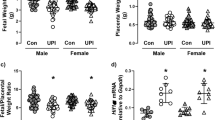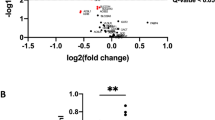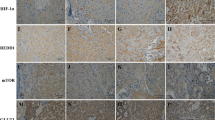Abstract
Preeclampsia (PE) is a pregnancy disorder characterized by high blood pressure, placental oxidative stress, and proteinuria. In a GeneFishing experiment using human preeclamptic placenta, expression of acyl-coenzyme A dehydrogenase very long chain (ACADVL), which is involved in fatty acid b-oxidation (FAO), was detected. To investigate the correlation between PE and FAO, this study subjected in vitro BeWo cells and in vivo pregnant mice to oxidative stress induced by hypoxia. Hypoxic condition, which oxygen supply is insufficient in cells and placenta, created a similar state to placental oxidative stress in PE, as evidenced by increased hypoxic (oxoguanine DNA glycosylase I, hypoxia inducible factor I alpha subunit) and preeclamptic markers (soluble fms-like tyrosine kinase I) both in vitro and in vivo. Increased expression of FAO-related genes (ACADVL, enoyl-coenzyme A hydratase/3-hydroxyacyl coenzyme A dehydrogenase) was observed in these models as well as in cases of preeclamptic preterm labor. In the in vivo liver model, messenger RNA expression of gluconeogenesis-related genes increased. Consequently, these results suggest that expression of FAO-related genes is regulated by hypoxic conditions and onset time of PE and affects maternal gluconeogenesis during pregnancy in patients with PE.
Similar content being viewed by others
References
Sibai, B, Dekker, G, Kupferminc, M Pre-eclampsia. Lancet. 2005; 365(9461):785–799.
Report of the National High Blood Pressure Education Program Working Group on High Blood Pressure in Pregnancy. Am J Obstet Gynecol. 2000;183(1):S1–S22.
Ness, RB, Roberts, JM Heterogeneous causes constituting the sin-gle syndrome of preeclampsia: a hypothesis and its implications. Am J Obstet Gynecol. 1996;175(5):1365–1370.
Sibai, BM Diagnosis and management of gestational hypertension and preeclampsia. Obstet Gynecol. 2003;102(1):181–192.
Roberts, JM Preeclampsia: what we know and what we do not know. Semin Perinatol. 2000;24(1):24–28.
Liou, JD, Pao, CC, Hor, JJ, Kao, SM Fetal cells in the maternal circulation during first trimester in pregnancies. Hum Genet. 1993;92(3):309–311.
Wataganara, T, Chen, AY, LeShane, ES, et al. Cell-free fetal DNA levels in maternal plasma after elective first-trimester termination of pregnancy. Fertil Steril. 2004;81(3):638–644.
Vatten, LJ, Skjaerven, R Is pre-eclampsia more than one disease? BJOG. 2004;111(4):298–302.
Caniggia, I, Winter, J, Lye, SJ, Post, M Oxygen and placental development during the first trimester: implications for the patho-physiology of pre-eclampsia. Placenta. 2000;21(suppl A): S25–S230.
Genbacev, O, Joslin, R, Damsky, CH, Polliotti, BM, Fisher, SJ Hypoxia alters early gestation human cytotrophoblast differentia-tion/invasion in vitro and models the placental defects that occur in preeclampsia. J Clin Invest. 1996;97(2):540–550.
Hung, TH, Charnock-Jones, DS, Skepper, JN, Burton, GJ Secretion of tumor necrosis factor-alpha from human placental tissues induced by hypoxia-reoxygenation causes endothelial cell activation in vitro: a potential mediator of the inflammatory response in preeclampsia. Am J Pathol. 2004;164(3):1049–1061.
Zamudio, S, Palmer, SK, Dahms, TE, et al. Blood volume expan-sion, preeclampsia, and infant birth weight at high altitude. J Appl Physiol. 1993;75(4):1566–1573.
Benyo, DF, Smarason, A, Redman, CW, Sims, C, Conrad, KP Expression of inflammatory cytokines in placentas from women with preeclampsia. J Clin Endocrinol Metab. 2001;86(6): 2505–2512.
Redman, CW, Sargent, IL Placental debris, oxidative stress and pre-eclampsia. Placenta. 2000;21(7):597–602.
Sargent, IL, Germain, SJ, Sacks, GP, Kumar, S, Redman, CW Tro-phoblast deportation and the maternal inflammatory response in pre-eclampsia. J Reprod Immunol. 2003;59(2):153–160.
Gratacos, E, Casals, E, Deulofeu, R, Cararach, V, Alonso, PL, Fortuny, A Lipid peroxide and vitamin E patterns in pregnant women with different types of hypertension in pregnancy. Am J Obstet Gynecol. 1998;178(5):1072–1076.
Mutlu-Turkoglu, U, Ademoglu, E, Ibrahimoglu, L, Aykac-Toker, G, Uysal, M Imbalance between lipid peroxidation and antioxidant status in preeclampsia. Gynecol Obstet Invest. 1998;46(1):37–40.
Uotila, JT, Tuimala, RJ, Aarnio, TM, Pyykko, KA, Ahotupa, MO Findings on lipid peroxidation and antioxidant function in hyper-tensive complications of pregnancy. Br J Obstet Gynaecol. 1993; 100(3):270–276.
Felig, P, Wahren, J Fuel homeostasis in exercise. N Engl J Med. 1975;293(21):1078–1084.
Neely, JR, Morgan, HE Relationship between carbohydrate and lipid metabolism and the energy balance of heart muscle. Annu Rev Physiol. 1974;36:413–459.
Dunning, KR, Cashman, K, Russell, DL, Thompson, JG, Norman, RJ, Robker, RL Beta-oxidation is essential for mouse oocyte developmental competence and early embryo development. Biol Reprod. 2010;83(6):909–918.
Herrera, E, Amusquivar, E Lipid metabolism in the fetus and the newborn. Diabetes Metab Res Rev. 2000;16(3):202–210.
Yang, H, Kim, TH, An, BS, et al. Differential expression of calcium transport channels in placenta primary cells and tissues derived from preeclamptic placenta. Mol Cell Endocrinol. 2013;367(1-2): 21–30.
Yang, H, Kim, TH, Lee, GS, Hong, EJ, Jeung, EB Comparing the expression patterns of placental magnesium/phosphorus-transporting channels between healthy and preeclamptic pregnancies. Mol Reprod Dev. 2014;81(9):851–860.
von Dadelszen, P, Magee, LA, Roberts, JM Subclassification of preeclampsia. Hypertens Pregnancy. 2003;22(2):143–148.
von Dadelszen, P, Magee, LA, Devarakonda, RM, et al. The pre-diction of adverse maternal outcomes in preeclampsia. J Obstet Gynaecol Can. 2004;26(10):871–879.
Jadoon, A, Cunningham, P, McDermott, LC Regulation of fatty acid binding proteins by hypoxia inducible factors 1alpha and 2alpha in the placenta: relevance to pre-eclampsia. Prostaglan-dins Leukot Essent Fatty Acids. 2015;93:25–29.
Lai, Z, Kalkunte, S, Sharma, S A critical role of interleukin-10 in modulating hypoxia-induced preeclampsia-like disease in mice. Hypertension. 2011;57(3):505–514.
Yang, H, An, BS, Choi, KC, Jeung, EB Change of genes in calcium transport channels caused by hypoxic stress in the placenta, duo-denum, and kidney of pregnant rats. Biol Reprod. 2013;88(2):30.
Caldecott, KW XRCC1 and DNA strand break repair. DNA Repair. 2003;2(9):955–969.
Mustafa, SA, Karieb, SS, Davies, SJ, Jha, AN Assessment of oxi-dative damage to DNA, transcriptional expression of key genes, lipid peroxidation and histopathological changes in carp Cyprinus carpio L following exposure to chronic hypoxic and subsequent recovery in normoxic conditions. Mutagenesis. 2015;30(1): 107–116.
Maynard, SE, Min, JY, Merchan, J, et al. Excess placental soluble fms-like tyrosine kinase 1 (sFlt1) may contribute to endothelial dysfunction, hypertension, and proteinuria in preeclampsia. J Clin Invest. 2003;111(5):649–658.
Shibuya, M Structure and function of VEGF/VEGF-receptor sys-tem involved in angiogenesis. Cell Struct Funct. 2001;26(1): 25–35.
Zhou, Y, McMaster, M, Woo, K, et al. Vascular endothelial growth factor ligands and receptors that regulate human cytotrophoblast survival are dysregulated in severe preeclampsia and hemolysis, elevated liver enzymes, and low platelets syndrome. Am J Pathol. 2002;160(4):1405–1423.
Pae, EK, Ahuja, B, Kim, M, Kim, G Impaired glucose homeostasis after a transient intermittent hypoxic exposure in neonatal rats. Biochem Biophys Res Commun. 2013;441(3):637–642.
Rui, L Energy metabolism in the liver. Compr Physiol. 2014;4(1): 177–197.
Shenoy, V, Kanasaki, K, Kalluri, R Pre-eclampsia: connecting angiogenic and metabolic pathways. Trends Endocrinol Metab. 2010;21(9):529–536.
Vuorela, P, Helske, S, Hornig, C, Alitalo, K, Weich, H, Halmes-maki, E Amniotic fluid–soluble vascular endothelial growth factor receptor-1 in preeclampsia. Obstet Gynecol. 2000;95(3): 353–357.
Redman, CW Current topic: pre-eclampsia and the placenta. Pla-centa. 1991;12(4):301–308.
Jaffe, R, Dorgan, A, Abramowicz, JS Color Doppler imaging of the uteroplacental circulation in the first trimester: value in predicting pregnancy failure or complication. Am J Roentgenol. 1995; 164(5):1255–1258.
Schneider, H Oxygenation of the placental-fetal unit in humans. Respir Physiol Neurobiol. 2011;178(1):51–58.
Murray, AJ Oxygen delivery and fetal-placental growth: beyond a question of supply and demand? Placenta. 2012;33(suppl 2): e16–e22.
Herrera, EA, Krause, B, Ebensperger, G, et al. The placental pursuit for an adequate oxidant balance between the mother and the fetus. Front Pharmacol. 2014;5:149.
Wang, GL, Jiang, BH, Rue, EA, Semenza, GL Hypoxia-inducible factor 1 is a basic-helix-loop-helix-PAS heterodimer regulated by cellular O2 tension. Proc Natl Acad Sci U S A 1995;92(12): 5510–5514.
Ivan, M, Haberberger, T, Gervasi, DC, et al. Biochemical purifica-tion and pharmacological inhibition of a mammalian prolyl hydroxylase acting on hypoxia-inducible factor. Proc Natl Acad Sci U S A 2002;99(21):13459–13464.
Ito, K, Suda, T Metabolic requirements for the maintenance of self-renewing stem cells. Nat Rev Mol Cell Biol. 2014;15(4): 243–256.
Shekhawat, P, Bennett, MJ, Sadovsky, Y, Nelson, DM, Rakheja, D, Strauss, AW Human placenta metabolizes fatty acids: implications for fetal fatty acid oxidation disorders and maternal liver diseases. Am J Physiol Endocrinol Metab. 2003;284(6): E1098–E1105.
Rakheja, D, Bennett, MJ, Foster, BM, Domiati- Saad, R, Rogers, BB Evidence for fatty acid oxidation in human placenta, and the relationship of fatty acid oxidation enzyme activities with gesta-tional age. Placenta. 2002;23(5):447–450.
Oey, NA, Ruiter, JP, Attie-Bitach, T, Ijlst, L, Wanders, RJ, Wijburg, FA Fatty acid oxidation in the human fetus: implications for fetal and adult disease. J Inherit Metab Dis. 2006;29(1): 71–75.
Eaton, S Control of mitochondrial beta-oxidation flux. Prog Lipid Res. 2002;41(3):197–239.
She, P, Shiota, M, Shelton, KD, Chalkley, R, Postic, C, Magnuson, MA Phosphoenolpyruvate carboxykinase is necessary for the integration of hepatic energy metabolism. Mol Cell Biol. 2000; 20(17):6508–6517.
Emerson K Jr, Saxena, BN, Poindexter, EL Caloric cost of normal pregnancy. Obstet Gynecol. 1972;40(6):786–794.
Author information
Authors and Affiliations
Corresponding author
Rights and permissions
About this article
Cite this article
Shin, EK., Kang, H.Y., Yang, H. et al. The Regulation of Fatty Acid Oxidation in Human Preeclampsia. Reprod. Sci. 23, 1422–1433 (2016). https://doi.org/10.1177/1933719116641759
Published:
Issue Date:
DOI: https://doi.org/10.1177/1933719116641759




